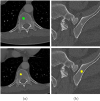|
 Genetic distance and ancestry proportion modify the association between maternal genetic risk score of type 2 diabetes and fetal growth
Genetic distance and ancestry proportion modify the association between maternal genetic risk score of type 2 diabetes and fetal growth
Habtewold, TD; Wijesiriwardhana, P; Biedrzycki, RJ; Tekola-Ayele, F; ,
Hum Genomics
, DOI://10.1186/s40246-024-00645-1 (2024)
 Weakly-Supervised Detection of Bone Lesions in CT
Weakly-Supervised Detection of Bone Lesions in CT
Sheng, T; Mathai, TS; Shieh, A; Summers, RM; ,
Proc SPIE Int Soc Opt Eng
, DOI://10.1117/12.3008823 (2024)
 The landscape of rare genetic variants in familial Waldenström macroglobulinemia
The landscape of rare genetic variants in familial Waldenström macroglobulinemia
Pemov, A; Kim, J; Luo, W et al.
Blood Neoplasia
, DOI://10.1016/j.bneo.2024.100013 (2024)
Whole-genome sequence of Mucor velutinosus NIH1002, a strain associated with disseminated disease
Conlan, S; Subramanian, P; Plata Barril, B et al.
Microbiol Resour Announc
, DOI://10.1128/mra.00062-24 (2024)
 Mriyaviruses: small relatives of giant viruses
Mriyaviruses: small relatives of giant viruses
Yutin, N; Mutz, P; Krupovic, M; Koonin, EV; ,
mBio
, DOI://10.1128/mbio.01035-24 (2024)
 Papillary tumor of the pineal region: analysis of DNA methylation profiles and clinical outcomes in 76 cases
Papillary tumor of the pineal region: analysis of DNA methylation profiles and clinical outcomes in 76 cases
Wu, Z; Dazelle, K; Abdullaev, Z et al.
Acta Neuropathol Commun
, DOI://10.1186/s40478-024-01781-4 (2024)
 K128 ubiquitination constrains RAS activity by expanding its binding interface with GAP proteins
K128 ubiquitination constrains RAS activity by expanding its binding interface with GAP proteins
Magits, W; Steklov, M; Jang, H et al.
EMBO J
, DOI://10.1038/s44318-024-00146-w (2024)
 Evaluation of the Therapeutic Potential of Sulfonyl Urea Derivatives as Soluble Epoxide Hydrolase (sEH) Inhibitors
Evaluation of the Therapeutic Potential of Sulfonyl Urea Derivatives as Soluble Epoxide Hydrolase (sEH) Inhibitors
Kundu, B; Dvorácskó, S; Basu, A et al.
Molecules
, DOI://10.3390/molecules29133036 (2024)
|
 All Services Operational
All Services Operational All Services Operational
All Services Operational